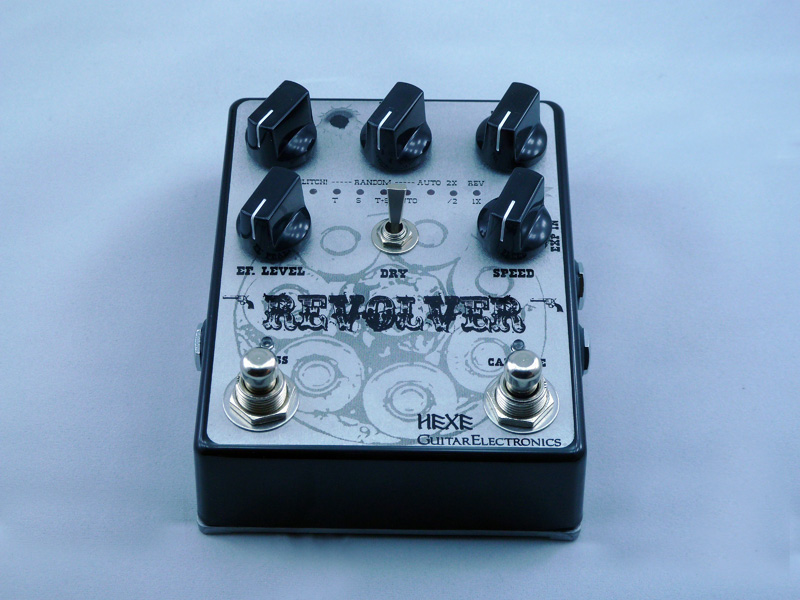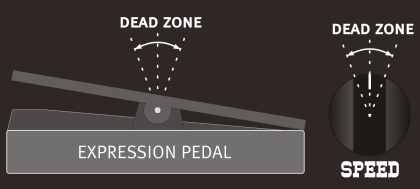
Micro sampler / glitch / stutter pedal.
The initial idea for the reVOLVER pedal, a device that can mimic a typical CD stuttering effect, rhythmic repetition of a small chunk of audio signal quickly evolved into a much more advanced granular type sonic texture generator which can drastically extend the range of instrument's sounds, especially if you are into more experimental types of music.
Controls:
- SPEED, play speed, can go from -2 octaves to +1 octave, depending on the MODE setting,
- TIME, sampling buffer size, range from 20ms to 1s,
- MODE, sets one of the 8 available working modes,
- TONE, tone regulator for the sampled signal,
- EF. LEVEL, sampled signal volume,
- DRY, mute switch for the dry signal, allows to play over the recorded samples and use the pedal as a looper,
- EXP IN, expression pedal input, when plugged, controls the SPEED parameter,
- CAPTURE, footswitch - starts the recording,
- BYPASS, footswitch - sets the pedal into bypass mode or plays the last recorded sample,
- INPUT GAIN (avaialable in revision IIb and later) - Instrument/Line input gain switch.
Operation:
Basic operation of the pedal is pretty straightforward. It records up to 1 second of audio material, keeps it in an infinite loop (basic stutter effect), changes the play speed (like in tape reel machines), reverse sthe play direction. Ontop of that there is a set of randomized modes, which use an internal random value generator to change the parameters each time you capture a new sample and an auto self retriggering mode in which the pedal captures the samples automatically.
One of the most interactive features is the sample TIME control. The knob sets the maximal sample buffer length only. The actual sample length is controlled by the time the CAPTURE footswitch is held down. That means, even if the TIME setting is set to max (1 second) you can still record shorter samples just by releasing the CAPTURE footswitch before the max available buffer time is up.
Working modes:
There are 8 available working modes. Except in the 1st one ("Glitch!"), used for an instant momentary type stutter effect, the sample capturing mechanism works as follows:
- press the CAPTURE footswitch and hold it to record a sample,
- a sample is recorded only when the CAPTURE is kept pressed,
- if you release the footswitch, the pedal starts to play the recorded sample,
- release the footswitch before the maximum buffer time (set with TIME knob) is up to get a shorter sample,
- if the CAPTURE footswitch is kept pressed for a longer period that the max buffer time (knob setting), the pedal starts to play the sample,
- in randomized modes (Random T, Random T+S, Auto) the sample length will be different for each capture.
The working modes are grupped into four main sections:
- Glitch! mode. In this mode the sound is recorded and played only when the CAPTURE footswitch is pressed. Releasing the footswitch causes the pedal to go into the true bypass mode. The play speed is normal (1x) and can be reversed using the SPEED knob. The Bypass footswitch is inactive.
- Random modes. In this mode a different parameters (Time, Speed, both together, self retrigger ratio) are purely random. The corresponding knobs control the spread of randomness.
- Auto mode. This is a self retriggering mode. It simulates a rhythmic capturing of a new sample in constant intervals, set with the SPEED knob. Because the maximum sampling time can't be longer than the retrig period, it is automatically rescaled according to the SPEED setting. The TIME knob can be used to set shorter samples anytime. This mode is also available as randomized - the retrigger ratio and sample length random values are generated for each new cycle.
- Pitch shifter / detune mode. In this mode pressing the CAPTURE footswich triggers the recording, after releasing the footswitch or when the buffer is full the pedal starts to play the recorded sample and keeps playing it until the BYPASS footswitch is pressed. There are two different settings for this mode.
Each of the 8 working modes operates as follows:
- Glitch! : instant glitch mode, momentary CAPTURE footswitch operation,
- Random Time: the actual sample time is a random value scaled by the TIME knob setting, each CAPTURE press generates a new value,
- Random Speed: randomized play speed mode,
- Random Time + Speed: both parameters are randomized and scaled by the corresponding knob settings,
- Random Auto: randomized self retriggering mode. The pedal captures a new sample in random intervals,
- Auto: self retriggering mode. A new sample is captured in constant intervals set with the SPEED knob,
- /2 ... 2x: speed range from 1 octave down (/2), through normal (dead zone) to 1 octave up (2x),
- 1x ... REV: special mode for reverse effect. The speed goes from normal (1x) to 2 octaves down (/4), in the middle position the play direction is reversed, then the speed increases to normal (1x), still in reversed direction.
Natural pitch dead zone:




